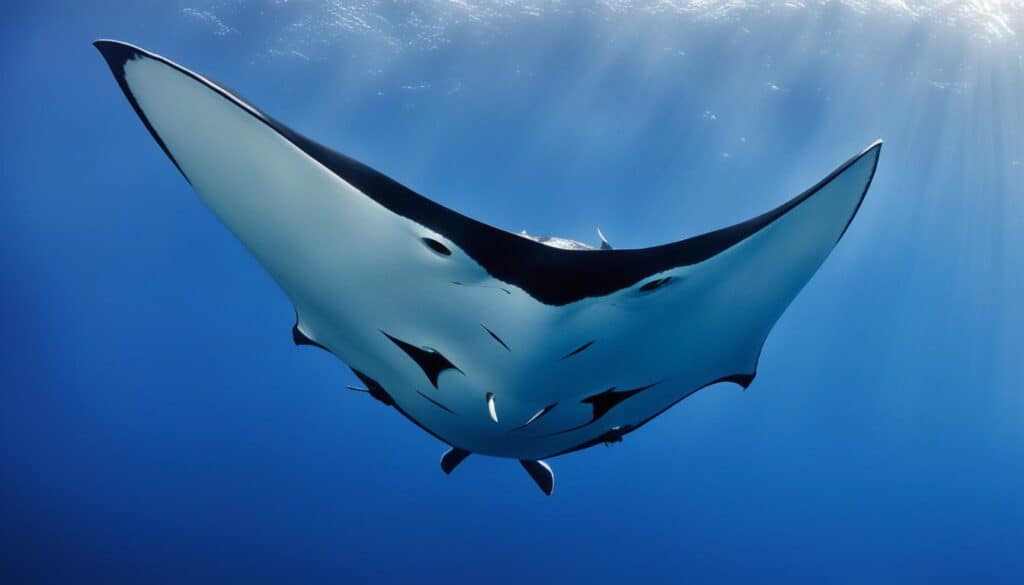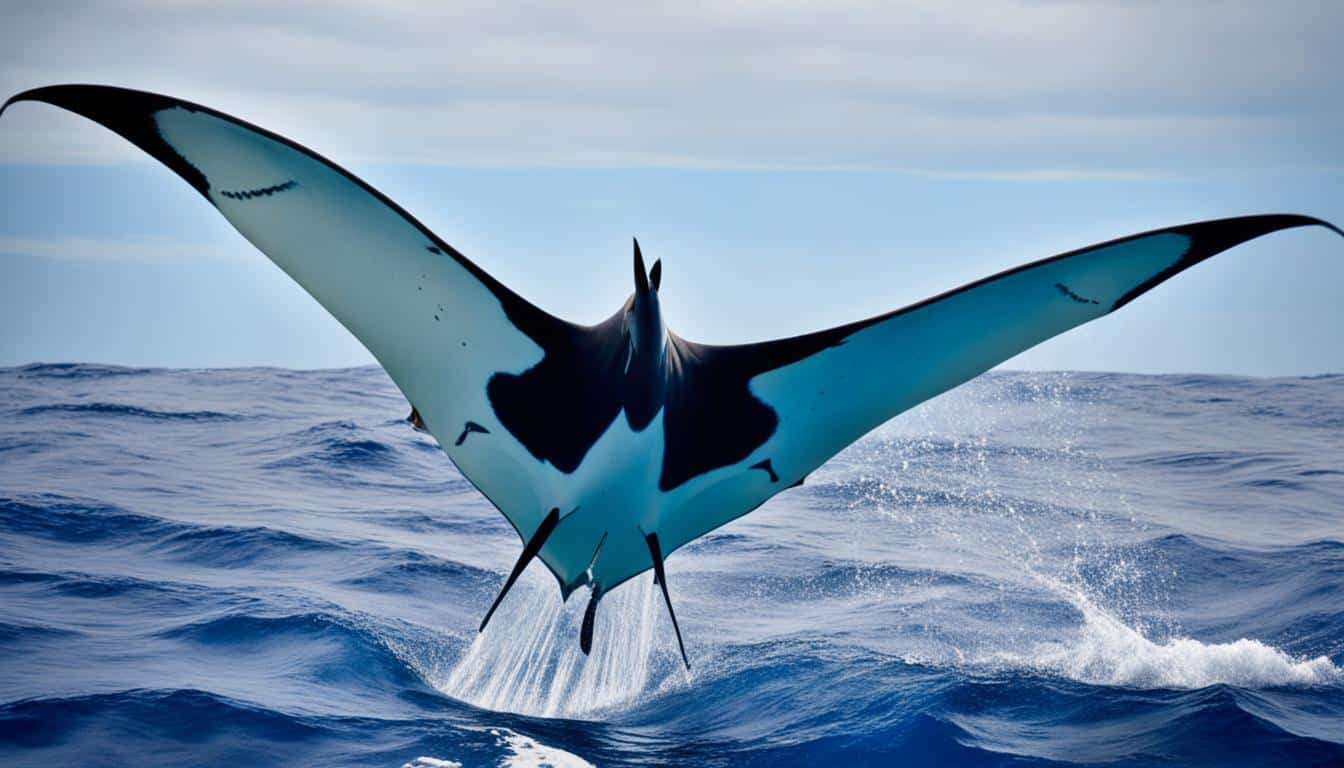Manta rays are truly awe-inspiring creatures, known as some of the largest fish in the ocean. They come in different sizes, with the giant manta ray being the largest. The giant manta ray has a huge wingspan and can weigh a lot. The reef manta ray is a bit smaller but still impressive.
Knowing how big manta rays get is important for many people. Marine enthusiasts and conservationists need to understand their size. This knowledge helps protect these amazing animals. As you learn more about manta rays, you’ll see how their size affects their behavior and role in the ocean.
Manta ray size and dimensions
Learning about the size and dimensions of manta rays can deepen your understanding of these amazing sea creatures. Both the giant and reef manta rays show unique traits that help them move and live in the ocean.
Average wingspan and length
The size of manta rays differs between species. Giant manta rays (Mobula birostris) can have wingspans up to 29.5 feet, with most around 22 feet wide. Reef manta rays (Mobula alfredi) are smaller, with females about 12 to 14 feet wide and males up to 10 feet. This shows how diverse these species can be.
Weight and physical characteristics
The weight of manta rays affects their buoyancy and how they move. Adult giant manta rays can weigh up to 4,000 pounds, showing their strong build. Reef manta rays are lighter, weighing 50 to 100 pounds for each foot of their length. Manta rays have a flat body and long fins that look like wings. These features help them swim smoothly through the water.
| Species | Wingspan | Weight |
|---|---|---|
| Giant Manta Ray | Up to 29.5 feet | Up to 4,000 lbs |
| Reef Manta Ray | 12-14 feet (females), up to 10 feet (males) | 50-100 lbs per foot |
How big do manta rays get?
Manta rays are amazing creatures that capture the hearts of many with their huge sizes. These sizes can vary a lot between different types of manta rays. Knowing how big they get helps us understand their lives and where they live.
Giant manta ray dimensions
The giant manta ray is truly massive. They can spread their wings up to 29.5 feet wide. Some stories even tell of a few reaching 30 feet. This huge size lets them feed on plankton by filtering a lot of water, which is key to their survival.
Reef manta ray measurements
Reef manta rays are much smaller, with wings up to 12 to 14 feet wide. They live in shallower waters and don’t travel as far as the giant manta rays. Their size affects how they act and their role in their ecosystems. This shows how different manta rays grow and adapt to various marine places.
Manta ray growth patterns
Manta rays grow in fascinating ways throughout their lives. Their growth patterns help us understand their development and how they adapt to their environments. This knowledge is key to knowing how they fit into marine ecosystems.
Growth stages of manta rays
Manta rays go through different growth stages. Baby manta rays, called pups, start off quite small. Reef manta ray pups are about 2 to 3 feet wide, while pelagic ones can be up to 6 feet wide right from the start. These young ones don’t get help from their parents and must find their way on their own. This shows how tough they are to survive.
Factors influencing size
Many things affect how big manta rays can get. Important factors include:
- Environmental Conditions: The health of their homes greatly affects how big manta rays can grow.
- Food Availability: Having plenty of food helps manta rays grow bigger.
- Genetic Factors: A manta ray’s genes help decide how big it can get, shaping its growth.
Knowing these factors helps us understand how manta rays grow and compare them to other sea creatures in size and flexibility.
Maximum size of manta rays
Manta rays are amazing creatures known for their huge sizes and beautiful movements in the ocean. They come in two main types: the giant manta ray and the reef manta ray. Each type has its own size and features that help us understand where they live and how they adapt.
Record sizes and anecdotal evidence
The largest manta ray can grow up to about 29.5 feet wide. Some stories even talk about ones up to 30 feet, but these are not always proven. These huge sizes make us wonder and ask more about these sea creatures.
Differences between reef and giant species
The reef manta ray is smaller and lives in coastal areas. The giant manta ray moves long distances and prefers deeper water. These differences affect how we protect them, as each needs its own special care.
| Manta Ray Species | Wingspan | Habitat |
|---|---|---|
| Giant Manta Ray | Up to 29.5 feet | Deep ocean waters |
| Reef Manta Ray | Up to 23 feet | Coastal regions |

Manta ray size comparison with other marine animals
Manta rays are often looked at alongside other big sea creatures because of their huge manta ray size. They can be bigger than many well-known fish, like sharks and dolphins. This manta ray size comparison shows how big they are in the ocean.
The giant manta ray’s wingspan can go up to 29 feet. This is bigger than many large sharks. Here’s a table that shows how big manta rays are compared to other sea animals:
| Animal | Average Size |
|---|---|
| Giant Manta Ray | Up to 29 feet (8.8 m) wingspan |
| Great White Shark | Up to 20 feet (6.1 m) |
| Oregon Coast Dolphin | Up to 12 feet (3.7 m) |
| Walrus | Up to 12 feet (3.7 m) |
| Common Bluefin Tuna | Up to 10 feet (3.0 m) |
These comparisons show how big manta rays are and why they’re important. Their size helps them feed and keeps the ocean healthy.
Conclusion
Manta rays are truly amazing, especially the giant ones with their huge wingspan. They are the largest rays in the world. These huge creatures can grow quite long, making them known as ocean giants. Reef mantas, on the other hand, are smaller but still capture our attention with their beauty.
Learning about their growth and sizes helps us understand their importance in the ocean. Their sizes vary due to different factors, making them interesting to study and admire. Comparing them to other sea creatures shows how unique they are.
Knowing about manta rays makes us appreciate them more and shows why we need to protect them. It’s vital to save their homes and keep them safe. These incredible creatures are key to keeping the ocean healthy.
FAQ
How big do manta rays get?
Manta rays are among the biggest fish in the ocean. The giant manta ray can grow up to 29.5 feet wide. The reef manta ray is usually 12-14 feet wide.
What is the maximum size of manta rays?
The biggest giant manta ray is about 29.5 feet wide. Some might be as long as 30 feet, but this is not proven.
How much do adult manta rays weigh?
Adult giant manta rays can weigh up to 4,000 pounds. Reef manta rays are much lighter, weighing 50 to 100 pounds for each foot of their length.
What are the physical characteristics of manta rays?
Manta rays have a flat body with long fins that look like wings. These fins help them swim smoothly through the water.
What are the growth stages of manta rays?
Manta rays grow in stages, becoming adults between 10 and 15 years old. Newborn reef mantas are 2 to 3 feet wide. Pelagic mantas are up to 6 feet wide at birth.
What factors influence the size of manta rays?
Many things affect manta ray size, like their home, food, and genes. Being able to find plankton helps them grow and get bigger.
What are the dimensions of a giant manta ray?
Giant manta rays are huge, reaching up to 29.5 feet wide. Some might even be as long as 30 feet, but this is not always confirmed.
How do reef manta rays compare in size?
Reef manta rays are smaller, with a wingspan of 12-14 feet. They live in shallower waters, unlike the giant mantas that move in deeper waters.
Are there any recorded sizes of manta rays?
Yes, the biggest giant manta rays are about 29.5 feet wide. There are old stories of a 30-foot manta ray, but these are not always proven.
What distinguishes reef mantas from giant mantas?
Reef mantas are smaller and live in coastal areas. Giant mantas are bigger and travel long distances. These differences affect their role in nature and how we protect them.
How do manta rays compare to other large marine animals in size?
Manta rays are among the biggest rays in the sea. They can be wider than many fish and sharks. This shows how important they are in the ocean.







